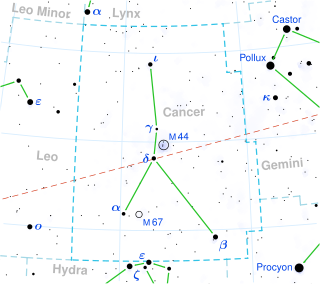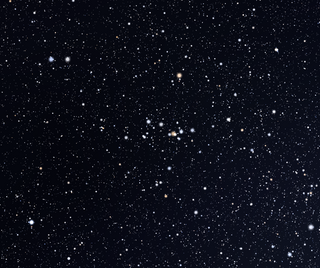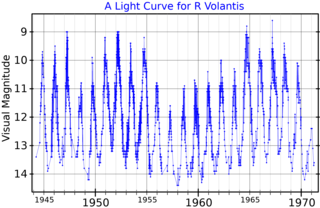
S Doradus is one of the brightest stars in the Large Magellanic Cloud (LMC), a satellite galaxy of the Milky Way, located roughly 160,000 light-years away. The star is a luminous blue variable, and one of the most luminous stars known, having a luminosity varying widely above and below 1,000,000 times the luminosity of the Sun, although it is too far away to be seen with the naked eye.

Iota Cancri is a double star in the constellation Cancer approximately 300 light years from Earth.
Kappa Leonis, Latinized from κ Leonis, is a double star in the constellation Leo. It was called Al-minħar al-asad, meaning the Lion's nose. The name is corrupted as Al Minliar al Asad in the Yale Bright Star Catalogue. This star is visible to the naked eye with an apparent visual magnitude of 4.46. It has an annual parallax shift of 16.20 mas as seen from Earth, which provides a distance estimate of about 201 light years. Kappa Leonis is moving away from the Sun with a radial velocity of +28 km/s.

DY Persei is a variable star and carbon star in the Perseus constellation. At maximum it is 11th magnitude and at its faintest it drops to 16th magnitude. DY Persei is the prototype of the very rare DY Persei class of variables that pulsate like red variables but also fade from sight like R Coronae Borealis variables.

Cygnus OB2 #12 is an extremely bright blue hypergiant with an absolute bolometric magnitude of −10.9, among the most luminous stars known in the galaxy. This makes the star nearly two million times more luminous than the Sun, although the estimate was less than half when the star was first discovered. It is now known to be a binary, with the companion approximately a tenth as bright. A very approximate initial estimate of the orbit gives the total system mass as 120 M☉ and the period as 30 years.
LN Andromedae, also known as HD 217811, HR 8768, is a formerly suspected variable star in the constellation Andromeda. Located approximately 458 parsecs (1,490 ly) away from Earth, it shines with an apparent visual magnitude 6.41, thus it can be seen by the naked eye under very favourable conditions. Its spectral classification is B2V, meaning that it's a hot main sequence star, emitting light approximately with a blackbody spectrum at an effective temperature of 18,090 K.
HD 82205 is a solitary star in the southern constellation Antlia. It is faintly visible to the naked eye with an apparent magnitude of 5.48 and is estimated to be 810 light years distant based on parallax measurements. However, it is receding with a heliocentric radial velocity of 12 km/s.

WOH G64 is an unusual red supergiant (RSG) star in the Large Magellanic Cloud (LMC) satellite galaxy in the southern constellation of Dorado. It is one of the largest known stars, being described as possibly being the largest star known. It is also one of the most luminous and massive red supergiants, with a radius calculated to be around 1,540 times that of the Sun (R☉) and a luminosity around 282,000 times the solar luminosity (L☉).
29 Camelopardalis is a double star in the circumpolar constellation Camelopardalis. With an apparent magnitude of 6.59, it's right below the max visibility to the naked eye, and can only be viewed under phenomenal conditions. The star is located 484 light years away based on parallax, but is drifting further away with a radial velocity of 3.9 km/s.
LSS 4067, also known as CD−38°11748, is an O-type blue supergiant star located in the constellation Scorpius, very close to the galactic plane. It is part of the open cluster HM 1, although its distance is not well known; it may be anywhere between 9,500 and 12,700 light years away from the Earth. Despite being a blue supergiant, it is extremely reddened by interstellar extinction, so its apparent magnitude is brighter for longer-wavelength passbands. Without the extinction, it is estimated that LS 4067 would be 5.8 magnitudes brighter, a naked eye star with an apparent magnitude of 5.3.

IRAS 19475+3119 is a protoplanetary nebula in the constellation of Cygnus, 15,000 light-years away. The central star, V2513 Cygni, is an F-type post-AGB star.

V915 Scorpii is an orange hypergiant variable star in the constellation Scorpius.
SP77 46-44 is a red supergiant star found in the Large Magellanic Cloud in the constellation of Dorado. It is one of the largest stars discovered, with a radius over 1,200 solar radii. If placed in our solar system, its photosphere would engulf the orbit of Jupiter.

HD 152408, also known as WR 79a, is a Wolf-Rayet star located in the constellation Scorpius, close to the galactic plane. Its distance is around 2,020 parsecs away from the Earth.

Westerlund 1-243 or Wd 1-243 is a luminous blue variable (LBV) star undergoing an eruptive phase located within the outskirts of the super star cluster Westerlund 1. Located about 13,400 ly (4,100 pc) from Earth, it has a luminosity of 0.73 million L☉ making it one of the most luminous stars known.
WR 138a is a Wolf-Rayet star in the constellation Cygnus. It is of a very late spectral type of WN9h. The WR is also at the centre of a ring nebula and is a runaway.
HD 33875 is a solitary star in the southern circumpolar constellation Mensa. With an apparent magnitude of 6.26, it is barely visible to the naked eye under ideal conditions. The star is located at a distance of 421 light years but is receding at a rate of 8 km/s.

R Volantis is a single variable star in the southern circumpolar constellation Volans. It has an average apparent magnitude of 8.7, making it readily visible in amateur telescopes but not to the naked eye. The object is relatively far at a distance of about 2,300 light years but is drifting closer with a radial velocity of −5 km/s.
42 Leonis Minoris is a solitary, bluish white hued star located in the northern constellation Leo Minor. It has a visual apparent magnitude of 5.35, allowing it to be faintly seen with the naked eye. Parallax measurements place it at a distance of 412 light years. The object has a heliocentric radial velocity of 12 km/s, indicating that it is drifting away from the Solar System.








